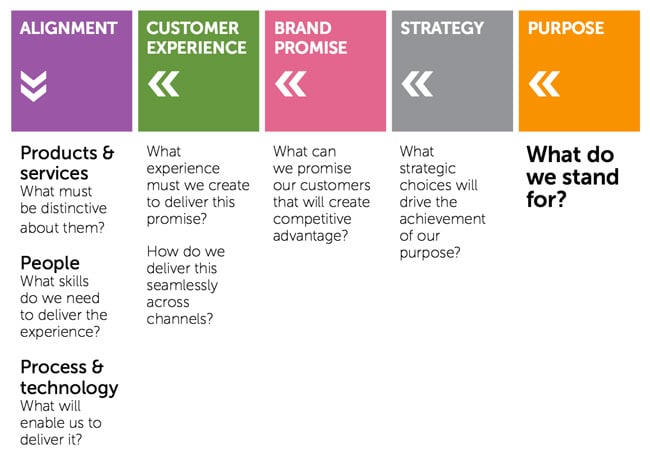Building a winning brand through customer experience design
This is the age of the empowered consumer. The Internet – that great leveller of playing fields – makes it possible for each of us to get detailed product information, search for the best price, and easily find reviews from other customers. We can also, with the touch of a button or click of a link, share our own product reviews, impressions, or customer service feedback with the entire world. Add to this that most business sectors are characterised by increasing – and often global – competition and it is easy to see why consumer expectations have only grown over time. Put another way, we generally expect the things we buy or the services we consume, including education, to be great. That is the starting point for most people today. And as customer expectations have continued to rise, businesses and institutions around the world are faced with the challenge of finding new sources of sustainable, competitive advantage. This is where customer experience comes in. It is one of the ideas gaining more traction among major brands in recent years and it brings with it a different level of understanding of the relationship between brands and customers. Beyond product features, price, marketing messages, and service experience, customer experience is the customer’s complete perception of a brand. It is formed (consciously and otherwise) by every interaction they have – by every touchpoint – with a business, organisation, or institution. Apple may well be the most prominent, global, and successful example of a brand that is highly focused on customer experience. Yes, Apple produces great phones and computers and other devices. But the company is also famously preoccupied with every point of contact between customers and the Apple brand. How do customers feel when they open a new Apple product? What do they see? How is everything packed and arranged and presented? Think as well about the impressions customers have when they walk into an Apple store. What is the space like? How are the products showcased? Can they find someone to help them? Can they pay quickly and easily? The Apple Store in the International Finance Centre Mall in Hong Kong That minute attention to detail, to the things that really matter to customers, is apparent in virtually everything that the company does. Particularly given that Apple is one of world’s largest and most profitable companies, other brands are now increasingly looking to such examples for ideas and insights into how they can have a greater impact in their own markets. "In any marketplace, you’ve got the big players," says customer experience expert Shaun Smith. "The opportunity now is to face up to the big guys and change the rules in your favour. It’s not just about being big any more, it’s about being innovative – in terms of the experience."
Change the rules, change the market
Mr Smith is a leading authority on customer experience. A noted author and speaker, he is also the founder of Smith+Co, a UK-based customer experience consultancy. He spoke earlier this week at a professional development and networking event organised by the Association of Language Travel Organisations (ALTO) in London where he set out the basic business case for a focus on customer experience: "Most marketplaces are so sophisticated that you can buy whatever you want whenever you want. Having a great product is necessary, but insufficient. Having great service is expected now. What you’ve got to have [to win] is an experience that really differentiates you and puts you in a market-winning position." Many markets, Mr Smith argues, are effectively shifting from products and services to experiences – the implication being that winning brands are those that consistently deliver a great experience that is really meaningful for customers. During his ALTO presentation, he offered three key elements of strategy for brands that want to change their markets by focusing on customer experience. In Smith+Co’s conception of brand strategy, these are framed as stand up, stand out, and stand firm.
Stand up
Mr Smith invited his ALTO audience to think about what their brands stand for in the minds of customers. He argues that this position – the basic purpose of your business or organisation – is the cornerstone of good strategy.
The following Smith+Co graphic illustrates how the foundation of a clear purpose can then lead to new insights and to a sharper focus on aligning the actual experience that customers have of your brand with what you stand for.

Stand out
The second key element of strategy calls on brands to be different – to set themselves apart from their competitors – in a way that creates value for customers. The underlying premise here is that not all touchpoints are equal. Rather, you have to choose carefully where to invest so that you are hitting areas that have a real impact on the experience of your customers. Brands pursue different strategies to stand out. Some have unconventional, engaging, or otherwise entertaining marketing and communications programmes. Others find ways to delivery truly memorable customer service. Every airline, for example, produces an in-flight safety video but only Virgin, quite in line with its witty, engaging brand personality, took the trouble to produce an entertaining six-minute version loaded with references to classic cinema. Innovation in customer experience design is, Mr Smith suggests, a pursuit of the “wow” – the moment or experience that will truly set your brand apart. Sticking with the airline industry for a moment, it is fair to say that most airlines would consider that their customer experience begins on check-in and ends somewhere around baggage pick-up. Customers, on the other hand, might feel that their experience begins with booking the flight, then fighting through traffic to get to the airport, and then navigating security, and so on. Virgin, again, has an answer for this in its Virgin Upper Class service. Upper Class passengers are picked up by a Virgin driver at their home or office, checked in while in the car en route to the airport, and then whisked – within a 10-minute guarantee – from curb to well-appointed lounge via a dedicated security screening. This may sound like a lot of additional expense, agrees Mr Smith, but he points out as well that the level of investment required to create a significant service impact across all of these familiar air passenger “pain points” is nothing compared to the cost of the latest airliner (arguably a more conventional area of investment in the ultra-competitive air travel business). Following this line of thinking back to international education, possible counterparts for the international student experience could be greater attention and innovation in pre-departure communications for incoming students, airport greeting and transfer services, or orientation and welcome services on arrival.
Stand firm
In the third pillar of his strategic framework for designing customer experience, Mr Smith explains that brands that aim to change their markets by delivering high-value customer experiences have to stand firm – that is, to create conditions for sustaining a successful brand position for the long-term. He offers a few points in this regard, including the importance of “rites and rituals,” or distinctive elements of the customer experience that are routinely repeated and celebrated. In an education context, for example, these might be things like graduation ceremonies or alumni receptions. He also highlights the importance of brand culture, noting the example of online retailer Zappos and its commitment to “delivering happiness” and outstanding customer experience. "This became its unifying purpose," writes Mr Smith. "But it wasn’t just some lofty ideal. It was translated into a strategy that drove everything the brand did…Every decision for the management team was now driven by creating the type of organisation and culture that could deliver their strategy of differentiating their customer experience." Zappos is also an interesting example of a brand with a strong commitment to its people, to selecting the right employees, to compensating them effectively, and training and supporting them consistently. Through such investments, the culture of the company becomes the brand, and vice versa. Finally, Mr Smith underscores the importance of measuring what matters – that is, tracking the customer experience at every touchpoint. This is not an argument for measuring customer satisfaction as such.
Satisfaction alone is often not enough of an indicator of customer experience; research has shown that 80% of customers that switched to another brand were satisfied with their previous supplier.
However, customers that are extremely satisfied and engaged with a brand are not only less likely to switch, they are more likely to be loyal, and highly profitable, customers and advocates for the long-term. That is the ultimate goal of a clear purpose and well-aligned strategy that consistently delivers a remarkable, distinct customer experience. That is the power of the “wow” moment, and a means for any brand to impact its market in new and profound ways. Want to explore further the role of customer service design for your organisation or brand? Try this self-assessment tool from Smith+co to help jumpstart your thinking.














